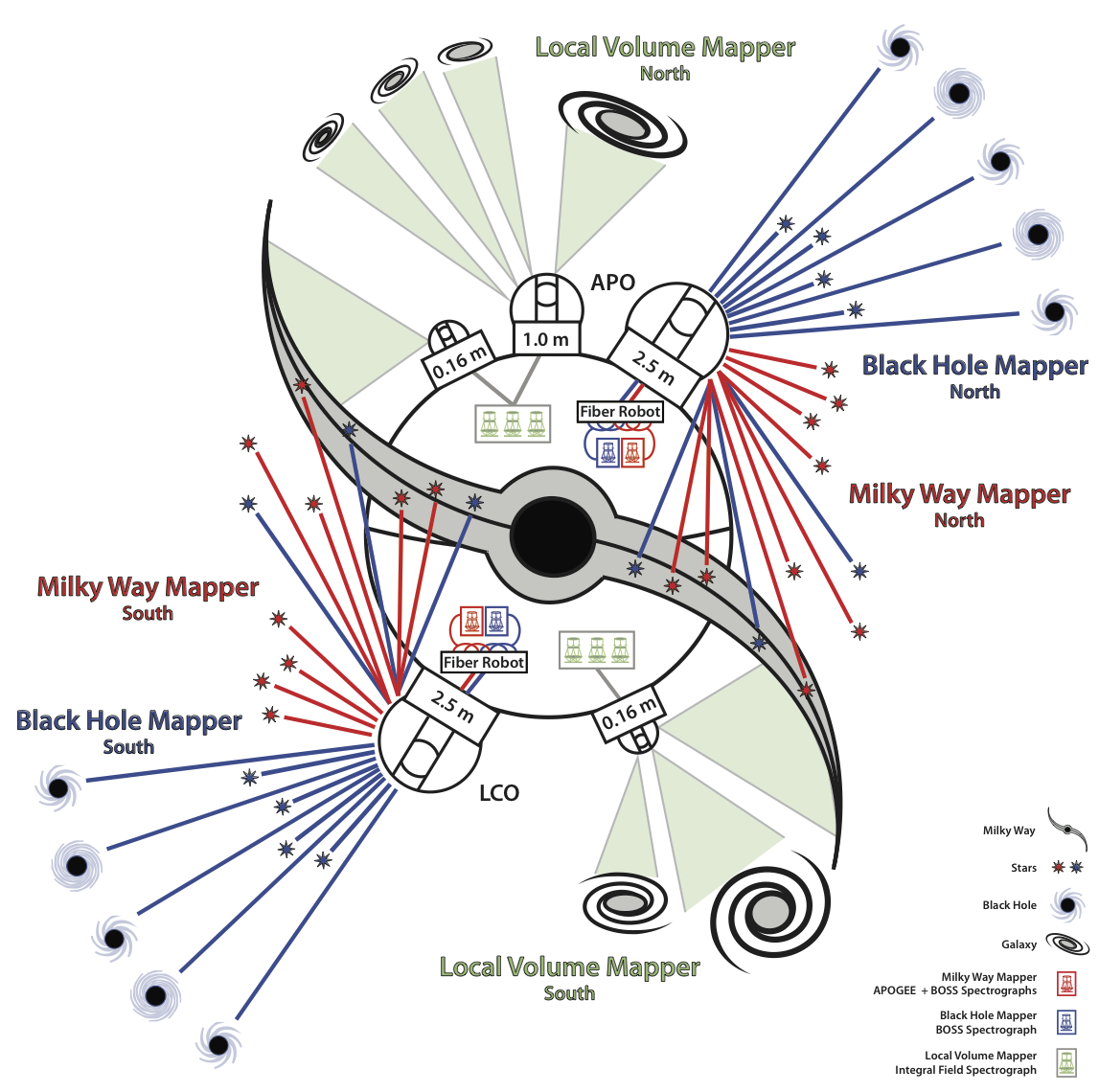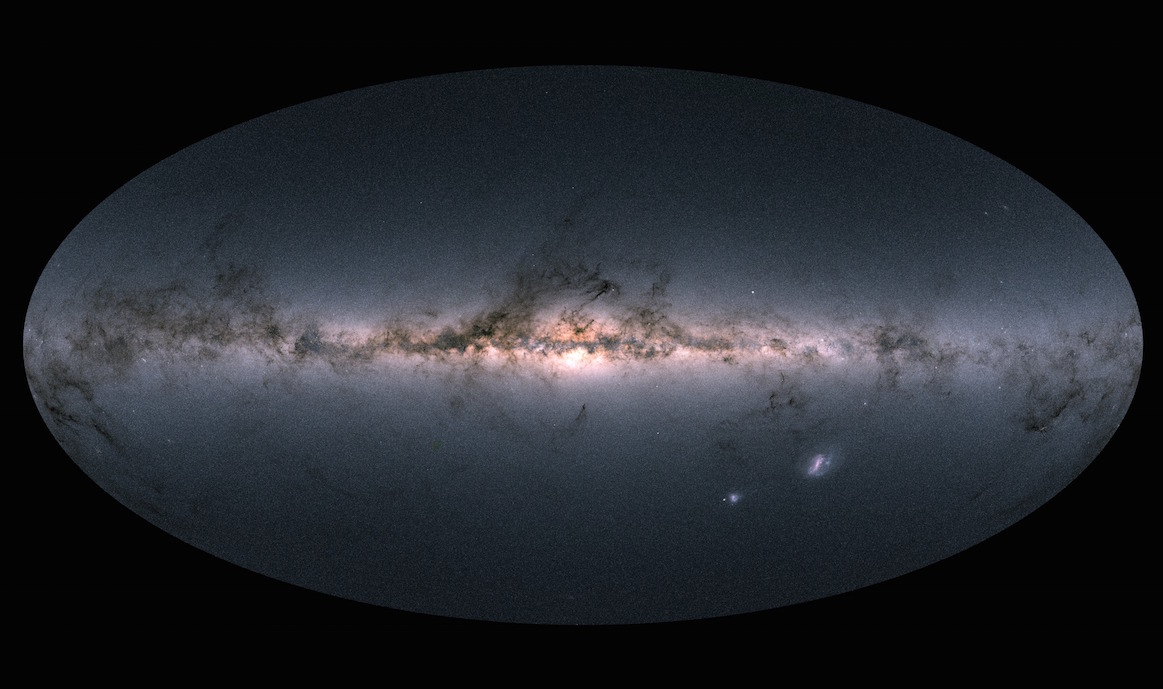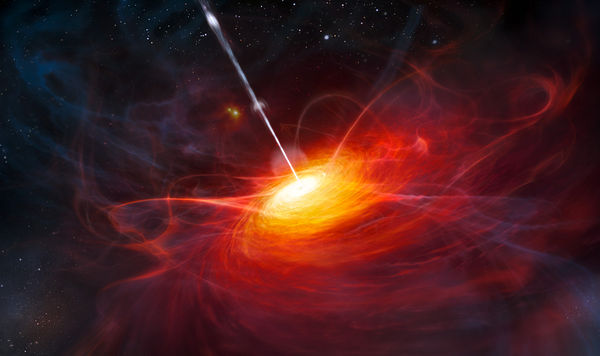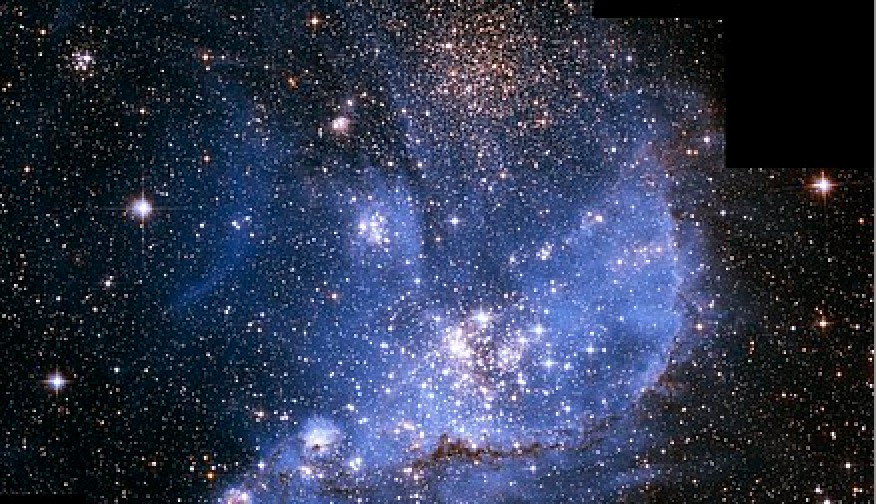SDSS-V: Pioneering Panoptic Spectroscopy
Multi-Object Spectroscopy: optical & near-IR, all-sky, multi-epoch
Integral Field Spectroscopy: optical, 3000 deg2, ultra wide-field

Image Credit: Juna A. Kollmeier and Hans-Walter Rix
Our white paper SDSS-V: Pioneering Panoptic Spectroscopy contains a fuller description of the survey’s ambitious goals and scope.
We submitted two white papers to the Astro2020 Decadal Survey (Blanton et al. 2019 and Kollmeier et al. 2019) which are highlighted on our SDSS and the Astro2020 Decadal Survey page.

Overview
SDSS-V is an all-sky, multi-epoch spectroscopic survey that will yield optical and IR spectra of over 6 million objects during its five year lifetime (2020-2025). Using SDSS’s existing and anticipated new facilities at Apache Point Observatory and Las Campanas Observatory, SDSS-V will survey the entire sky — mapping the Milky Way using rapid, repeated observations, mapping Local Volume galaxies using wide-angle integral field spectroscopy, and mapping black holes using time domain spectroscopy of quasars and bright X-ray sources. Instead of SDSS’s classic plugplate system, SDSS-V will use a new, custom-built robotic positioning system to allow for rapid configuration of fibers. These fibers will lead to the existing APOGEE and BOSS spectrographs, enabling simultaneous IR and optical observations. In addition, new wide-field integral-field units are being deployed to observe the stars and interstellar medium in the Milky Way, Magellanic Clouds, and local galaxies such as M31 at unprecedented spatial resolution.
More information about SDSS-V and its place in the astronomical landscape during the 2020s can be found in our white paper SDSS-V: Pioneering Panoptic Spectroscopy.
Mappers
SDSS-V comprises three key programs, called Mappers:
The Milky Way Mapper (MWM) will target 4-5 million stars across the Milky Way, collecting infrared spectra with an APOGEE spectrograph and/or optical spectra with a BOSS spectrograph. The MWM seeks to understand the evolution of the Milky Way, the physics of its stars and interstellar medium, and the architecture of multiple-star and planetary systems.
The Black Hole Mapper (BHM) will target over 400,000 sources, primarily black holes, with a BOSS optical spectrograph. Many of these will be observed numerous times, with the goal of measuring black hole masses, probing black hole growth across cosmic time, and characterizing the X-ray sky.
The Local Volume Mapper (LVM) will observe the interstellar medium and stellar populations in the Milky Way and several local galaxies, collecting more than 25 million contiguous spectra over 3,000 square degrees on the sky. The LVM will use new integral-field spectrographs to explore the physics of star formation and the interactions between stars and the interstellar medium.
Click on the Mapper buttons below for more details.
Milky Way Mapper
Image credit: ESA/Gaia/DPAC
Explore the Milky Way Mapper
Program Head: Jennifer Johnson (The Ohio State University)
Black Hole Mapper
Image credit: ESO/M. Kornmesser
Explore the Black Hole Mapper
Program Head: Scott Anderson (University of Washington)
Local Volume Mapper
Image credit: NASA, ESA/A. Nota
Explore the Local Volume Mapper
Program Head: Niv Drory (University of Texas at Austin)
Join us!
SDSS-V, like previous SDSS surveys, will remain committed to making its data publicly available in a format that is helpful to a broad range of users, from beginner students to both amateur and professional astronomers. However, without federal or other large-scale funding, this commitment is not possible without membership contributions from institutional partners. SDSS-V is currently under development and actively seeking funding from partners. Our institutional partners benefit from early access to data, participation in the survey planning process, and involvement of their faculty, postdocs, and students in the science collaborative network.
Policies for joining the program can be found in the Joining Document. The general policies for SDSS-V are defined in its current Principles of Operation; the member institutions will review these policies prior to the start of SDSS-V operations.
To encourage new institutions interested in SDSS-V to join the SDSS science collaboration now, we are announcing the following opportunity for SDSS-V institutions to also join SDSS-IV for a small additional price. Namely, for SDSS-V institutions, each SDSS-IV “slot” will be priced at \$25,000, rather than the original price of \$210,000. The cost would scale with the number of slots for larger memberships, in the ordinary fashion defined in the SDSS-IV Principles of Operation. Institutions can take advantage of this incentive to bring their total number of SDSS-IV slots up to but not exceeding their total number of SDSS-V slots. The SDSS-IV portion of the payments will be due upon signing the SDSS-IV MOU, whereas the SDSS-V portion of the payments will be due on a normal schedule or as negotiated with SDSS-V.
Current membership
SDSS-V has gathered a strong set of institutional members that have signed Memoranda of Understanding as of January 2019. More institutions are in various stages of approving membership.
- Full Member Institutional
- Harvard University
- Johns Hopkins University
- Max-Planck-Institut für Astronomie
- Max-Planck-Institut für Extraterrestrische Physik
- National Astronomical Observatories of China, Chinese Academy of Sciences
- New Mexico State University
- Space Telescope Science Institute
- The Ohio State University
- Universidad Nacional Autónoma de México
- University of Colorado Boulder
- University of Utah
- Yale University
- Participation Groups
- Chilean National Time Allocation Committee
- Gotham Participation Group
- Columbia University
- Flatiron Institution Center for Computational Astrophysics
- New York University
- Stellar Astrophysics Participation Group
- KU Leuven
- University of Warwick
- Vanderbilt University
- Associate Member Institutions
- École Polytechnique Fédérale de Lausanne
- Georgia State University
- I-CORE
- Kavli Institute for Astronomy and Astrophysics
- Leibniz-Institut für Astrophysik
- Pennsylvania State University
- Tel Aviv University
- Texas Christian University
- University of Illinois Urbana-Champaign
- University of Pennsylvania
- University of Pittsburgh
- University of Victoria
- University of Washington
- York University
Leadership and contact information
SDSS-V is led by Director Juna A. Kollmeier (Carnegie Observatories) and Project Scientist Hans-Walter Rix (Max-Planck-Institut für Astronomie), with support from their Management Committee and the SDSS-V Advisory Council.
For more information about SDSS-V, please contact Director Juna Kollmeier or SDSS-V Spokesperson Gail Zasowski (University of Utah).





